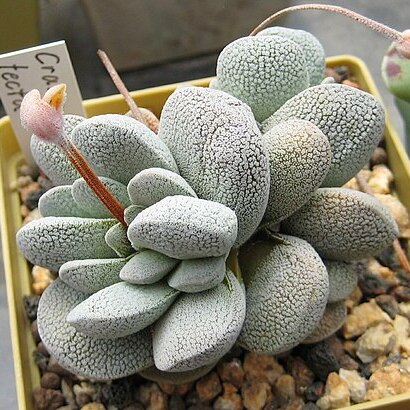Perennial herb, succulent, basal rosette, much branched, ± 0.03-0.05 m high, old leaves not deciduous. Leaves oblong to lanceolate, 20-35 x 5-12 mm, rounded, dorsiventrally compressed, convex both sides, covered with hard papillae towards apex and cilia toward base, grey-green. Inflorescence a spherical thyrse, several dichasia; distinct peduncle 30-80 mm long, covered with papillae. Calyx fleshy, grey-green, covered with hairs and marginal cilia. Corolla tubular, fused 0.8 mm, white or cream-coloured; lobes oblong-lanceolate, 3-4 mm long, obtuse, indistinct dorsal appendage, scarcely recurved. Flowering time Apr.-June.
Perennial, with few, short branches covered by leaves to form rosettes, 20-60 mm diam. Leaves sessile, oblong to oblanceolate, dorsiventrally compressed but convex, 20-35 x 5-12 mm, greyish, covered with coarse, white, swollen papillae, margin often ciliate near base. Flowers in a dense, spherical head on a papillate peduncle 30-80 mm long, tubular, petals 3-4 mm long, fused in lower 0.8 mm, with blunt to subacute tips, white to cream.
Tufted perennial, often much branched. Leaves opposite, oblanceolate, covered with hard papillae. Flowers in rounded clusters on papillate peduncles, tubular, whitish, petals 3-4 mm long.

